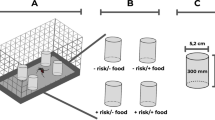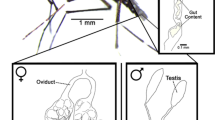Abstract
The plant allelochemical l-mimosine (β-[N-(3-hydroxy-4-pyridone)]-α-aminopropionic acid; leucenol) resembles the nonessential amino acid, tyrosine. Because the obligate intracellular alphaproteobacterium, Wolbachia pipientis, metabolizes amino acids derived from host cells, the effects of mimosine on infected and uninfected mosquito cells were investigated. The EC50 for mimosine was 6–7 μM with Aedes albopictus C7-10 and C/wStr cell lines, and was not influenced by infection status. Mosquito cells responded to concentrations of mimosine substantially lower than those used to synchronize the mammalian cell cycle; at concentrations of 30–35 μM, mimosine reversibly arrested the mosquito cell cycle at the G1/S boundary and inhibited growth of Wolbachia strain wStr. Although lower concentrations of mimosine slightly increased wStr abundance, concentrations that suppressed the cell cycle reduced Wolbachia levels.





Similar content being viewed by others
References
Appelhoff RJ, Tian YM, Raval RR, Turley H, Harris AL, Pugh CW, Ratcliffe PJ, Gleadle JM (2004) Differential function of the prolyl hydroxylases PHD1, PHD2, and PHD3 in the regulation of hypoxia-inducible factor. J Biol Chem 279:38458–38465
Baldridge GD, Baldridge AS, Higgins LA, Witthuhn BA, Markowski TW, Fallon AM (2014) Proteomic profiling of a robust Wolbachia infection in an Aedes albopictus mosquito cell line. Mol Microbiol 94:537–556
Beare PA, Sandoz KM, Omsland A, Rockey DD, Henzein RA (2011) Advances in genetic manipulation of obligate intracellular bacterial pathogens. Front Microbiol 2:1–13
Brennan LJ, Keddie BA, Braig HR, Harris HL (2008) The endosymbiont Wolbachia pipientis induces the expression of host antioxidant proteins in an Aedes albopictus cell line. PLoS One 3(5):e2083. doi:10.1371/journal.pone.0002083
Chang HC, Lee TH, Chuang LY, Yen MH, Hung WC (1999) Inhibitory effect of mimosine on proliferation of human lung cancer cells is mediated by multiple mechanisms. Cancer Lett 145:1–8
Choi JJ, Oh YK, Kim HS, Kim HC, Ko KH, Kim WK (2002) Mimosine prevents the death of glucose-deprived immunostimulated astrocytes by scavenging peroxynitrite. GLIA 39(1):37–46
Dong Z, Zhang JT (2003) EIF3 p170, a mediator of mimosine effects on protein synthesis and cell cycle progression. Mol Biol Cell 14:3942–3951
Dulbecco R, Vogt M (1954) Plaque formation and isolation of pure lines with poliomyelitis virus. J Exp Med 99:167–182
Fallon AM (2008) Cytological properties of an Aedes albopictus mosquito cell line infected with Wolbachia strain wAlbB. In Vitro Cell Dev Biol-Anim 44:154–161
Fallon AM (2014) Flow cytometric evaluation of the intracellular bacterium, Wolbachia pipientis, in mosquito cells. J Microbiol Methods 107:119–125
Fallon AM, Baldridge GD, Carroll EM, Kurtz CM (2014) Depletion of host cell riboflavin reduces Wolbachia levels in cultured mosquito cells. In Vitro Cell Dev Biol-Anim 50:707–713
Fallon AM, Baldridge GD, Higgins LA, Witthuhn BA (2013a) Wolbachia from the planthopper Laodelphax striatellus establishes a robust, persistent, streptomycin-resistant infection in clonal mosquito cells. In vitro Cell Dev Biol-Animal 49:66–73
Fallon AM, Kurtz CM, Carroll EM (2013b) The oxidizing agent, paraquat, is more toxic to Wolbachia than to mosquito host cells. In vitro Cell Dev Biol-Anim 49:501–507
Fallon AM, Hellestad VJ (2008) Standardization of a colorimetric method to quantify growth and metabolic activity of Wolbachia-infected mosquito cells. In Vitro Cell Dev Biol-Anim 44:351–356
Gerenday A, Blauwkamp TS, Fallon AM (1997) Synchronization of Aedes albopictus mosquito cells using hydroxyurea. Insect Mol Biol 6:191–196
Hallak M, Vazana L, Shpilberg O, Levy I, Mazar J, Nathan I (2008) A molecular mechanism for mimosine-induced apoptosis involving oxidative stress and mitochondrial activation. Apoptosis 13:147–155
Hosokawa T, Koga R, Kikuchi Y, Meng X-Y, Fukatsu T (2010) Wolbachia as a bacteriocyte-associated nutritional mutualist. Proc Natl Acad Aci USA 107:769–774
Hotopp JC, Lin M, Madupu R, Crabtree J, Angiuoli SV, Eisen JA et al (2006) Comparative genomics of emerging human ehrlichiosis agents. PLoS Genet 2(2):e21. doi:10.1371/journal.pgen.0020021
Hughes TA, Cook PR (1996) Mimosine arrests the cell cycle after cells enter S-phase. Exp Cell Res 222:275–280
Kulp KS, Vulliet PR (1996) Mimosine blocks cell cycle progression by chelating iron in asynchronous human breast cancer cells. Toxicol Appl Pharmacol 139:356–364
Mladenov E, Anachkova B (2003) DNA breaks induction by mimosine. Zeitschrift fur Naturforschung. Section C. J Biosci 58:732–735
Noda H, Miyoshi T, Koizumi Y (2002) In vitro cultivation of Wolbachia in insect and mammalian cell lines. In Vitro Cell Dev Biol-Anim 38:423–427
O’Neill SL, Pettigrew MM, Sinkins SP, Braig HR, Andreadis TG, Tesh RB (1997) In vitro cultivation of Wolbachia pipientis in an Aedes albopictus cell line. Insect Mol Biol 6:33–39
Oppenheim EW, Nasrallah IM, Mastri MG, Stover PJ (2000) Mimosine is a cell-specific antagonist of folate metabolism. J Biol Chem 275:19268–19274
Park SY, Im JS, Park SR, Kim SE, Wang HJ, Lee JK (2012) Mimosine arrests the cell cycle prior to the onset of DNA replication by preventing the binding of human Ctf4/And-1 to chromatin via Hif-1α activation in HeLa cells. Cell Cycle 11:761–766
Perry C, Sastry R, Nasrallah IM, Stover PJ (2005) Mimosine attenuates serine hydroxymethyltransferase transcription by chelating zinc. Implications for inhibition of DNA replication. J Biol Chem 281:396–400
Shih KM, Gerenday A, Fallon AM (1998) Culture of mosquito cells in Eagle’s medium. In Vitro Cell Dev Biol-Anim 34:629–630
Sinkins SP, Gould F (2006) Gene drive systems for insect disease vectors. Nat Rev Genet 7:427–435
Smith TG, Talbot NP (2010) Prolyl hydroxylases and therapeutics. Antioxid Redox Signal 12:431–433. doi:10.1089/ars.2009.2901
Szuts D, Krude T (2004) Cell cycle arrest at the initiation step of human chromosomal DNA replication causes DNA damage. J Cell Sci 117:4897–4908
Thumbi DK, Arif B, Krell PJ (2007) Susceptibility of Autographa californica multiple nucleopolyhedrosis to inhibitors of DNA replication. J Virol Methods 146:209–217
Wu M, Sun LV, Vamathevan J, Riegler M, Deboy R, Brownlie JC et al (2004) Phylogenomics of the reproductive parasite Wolbachia pipientis wMel: a streamlined genome overrun by mobile genetic elements. PLoS Biol 2:E69
Acknowledgments
This work was supported by NIH grant AI 081322 and by the University of Minnesota Agricultural Experiment Station, St. Paul, MN.
Author information
Authors and Affiliations
Corresponding author
Additional information
Editor: T. Okamoto
Rights and permissions
About this article
Cite this article
Fallon, A.M. Effects of mimosine on Wolbachia in mosquito cells: cell cycle suppression reduces bacterial abundance. In Vitro Cell.Dev.Biol.-Animal 51, 958–963 (2015). https://doi.org/10.1007/s11626-015-9918-7
Received:
Accepted:
Published:
Issue Date:
DOI: https://doi.org/10.1007/s11626-015-9918-7




